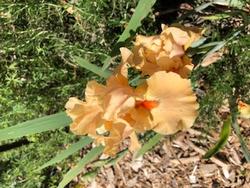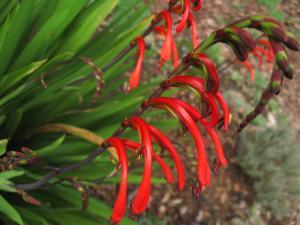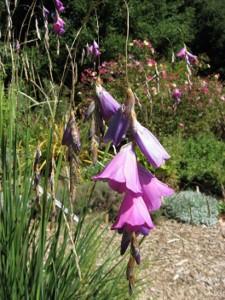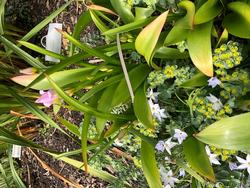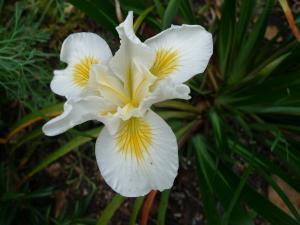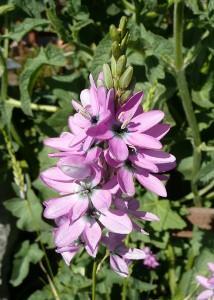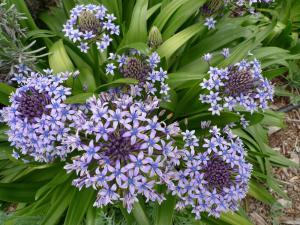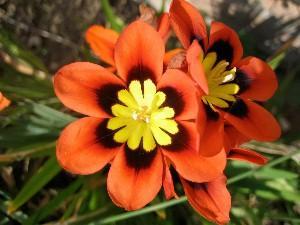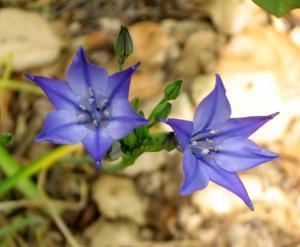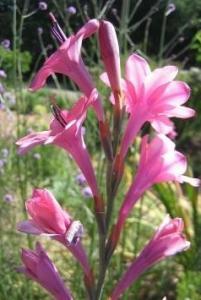Water Wise Plants
Here's a full list of all our water wise plants. You can also view an image gallery, or view the plants by categories.
Bearded Iris
Pronunciation
Common Name
Bearded Iris
Plant Type
Bulb
Mature Size
1.5 to 4 feet high Spreads via rhizomes
Water Requirements
Low: water every three weeks until the root ball is wet
Sun/Shade Requirements
Full to half sun
Wildlife
Flower Color
Many colors except true red and green,
Where to See
Maintenance- Design- Planting Tips
Bearded irises are beloved for their showy spring flowers, structurally pleasing upright, green leaves and low, summer water needs. They come in a wide range of colors and shapes. Choosing a mix of early, mid and late bloomers prolongs the spring bloom period, and the addition of re-blooming varieties gives another flush of flowers in the fall and winter season. Unfortunately, re-blooming varieties do need water year-round to re-bloom, and the second bloom has fewer flowers. All bearded irises need full sun for at least half the day to bloom well.
Given enough water from late fall through spring, intermediate bearded iris can grow to a height of 2.5 feet tall, and tall bearded iris can reach 4 feet in height. With enough water they develop tall flower stalks supporting numerous large blooms. With less water during the growing season, the plants are smaller with fewer flowers, but the blooms are still striking. Improve growth by adding compost and mulch in the fall, which helps retain soil moisture and provides nutrients for better bloom. Allow plant leaves and soil to dry out between watering to prevent fungal infections and flower loss. During the summer, bearded irises are dormant, and their leaves die back. For aesthetics many people cut the leaves back when they begin to yellow, but it is not necessary. Plants remain healthy with and without summer trims. Be aware though, there is one major maintenance issue when growing bearded iris. These plants grow from thick rhizomes. Each year new rhizomes spread from the original making a larger clump. As the older rhizomes die, a dead spot will eventually appear in the center of the iris clump. To prevent this from happening and to keep clump size in check, divide iris rhizomes about every three years. Do this during the hot summer months when plants are dormant and fungal infections are less likely to affect the cuts from the mother rhizomes. |
Chasmanthe
Pronunciation
chas-MAN-thee
Common Name
Chasmanthe or cobra lily
Plant Type
Bulb
Mature Size
3 ft. to 3 1/2 ft. tall
Water Requirements
Low: water every three weeks until the root ball is wet
Sun/Shade Requirements
Full to half sun
Wildlife
Flower Color
Orange-red
Where to See
Maintenance- Design- Planting Tips
Chasmanthe is one of the South African perennials that does very well in the Santa Clara County climate. Foliage appears in the fall, orange-red flowers appear in the winter, and the plant goes dormant in the summer. Chasmanthe needs no summer water. There is also a yellow flowered version, called Chasmanthe floribunda duckittii.
For best flowering, corms should be divided every two to three years. Be aware that the plant will reseed vigorously, particularly Chasmanthe aethiopica, so be sure to deadhead the flowers if this is not desired. |
Dierama pendulum
Pronunciation
dy-er-AH-muh
Common Name
Fairy Wand, Angel’s Fishing Rod
Plant Type
Bulb
Mature Size
Leaves to 2 ft. long, stems 4-7 ft. tall
Water Requirements
Low: water every three weeks until the root ball is wet
Sun/Shade Requirements
Full sun
Wildlife
Flower Color
Purplish pink to pink to white
Where to See
Maintenance- Design- Planting Tips
Fairy Wand, also known as Angel’s Fishing Rod, has stunning flowers on long arching stems. It is certainly a “what is that?!” plant when it blooms in late spring and early summer. Be sure to put it in a spot that will showcase its tall blooms.
If the plant gets too big, the corms can be divided and replanted. Fairy Wand self sows, though heavy mulching may discourage seedlings. If reseeding is a problem, deadhead the flowers before they set seed. Fairy Wand is usually evergreen in Santa Clara County’s climate, but leaves can be cut back in mid-summer if they become unattractive. Otherwise, this is a trouble-free plant with a big impact when it blooms. PADG notes: Fairy Wand is said to need regular water, but a once every three weeks watering regime has worked well. |
Ipheion uniflorum
Pronunciation
IF-ee-on yoo-nee-FLOR-um
Common Name
Starflower
Plant Type
Bulb
Mature Size
0.5' high x Spreads
Water Requirements
Moderate: water weekly until the root ball is wet
Sun/Shade Requirements
Full to half sun
Wildlife
Flower Color
Where to See
Maintenance- Design- Planting Tips
Ipheion uniflorum has low-growing green leaves and is covered with white star-shaped flowers in early spring. It dies down to the bulb after bloom and resprouts when fall and winter rains begin. It is a dainty and beautiful addition to garden edge. It reliably complements the early blooming narcissus and other spring flowers and requires little maintenance other than extra water if it does not rain during bloom.
|
Iris ‘Canyon Snow’
Pronunciation
EYE-riss
Common Name
Pacific Coast Iris ‘Canyon Snow’
Plant Type
Bulb
Mature Size
Flower stems reach 8 in. to 24 in. high
Water Requirements
Low: water every three weeks until the root ball is wet
Sun/Shade Requirements
Full to half sun
Wildlife
Flower Color
White
Where to See
Maintenance- Design- Planting Tips
There are many hybrids of Pacific Coast iris, some of which are very showy. Flower colors available include white, blue, pink, copper, brown, maroon, and violet. The flowers appear in the spring. The cultivar ‘Canyon Snow’ is said to tolerate full sun better than many other California native irises, as well as being more vigorous and floriferous. UC Davis has included this cultivar on the Arboretum All-Stars list.
Master Gardeners have found that Pacific Coast irises seem to prefer part shade and low to moderate water. Native irises are useful under oaks, in woodland gardens, and in meadows. |
Ixia
Pronunciation
IKS-ee-uh
Common Name
African Corn Lily
Plant Type
Bulb
Mature Size
18 - 20 in. tall
Water Requirements
None: avoid summer water
Sun/Shade Requirements
Full sun
Wildlife
Flower Color
Cream, yellow, red, orange, and pink
Where to See
Maintenance- Design- Planting Tips
This versatile South African bulb is one of the best kept secrets of a Mediterranean garden. The late spring flowers come in pretty jewel tone colors that go well with many spring-blooming plants. The grass-like foliage on this plant can be removed when it goes brown and dormant in the summer. While it prefers no summer water, it can tolerate some.
|
Scilla peruviana
Pronunciation
SILL-ah per-u-vee-AN-uh
Common Name
Giant Scilla
Plant Type
Bulb
Mature Size
Less than 1 ft. tall
Water Requirements
Low: water every three weeks until the root ball is wet
Sun/Shade Requirements
Full sun
Wildlife
Flower Color
Blue, white
Where to See
Maintenance- Design- Planting Tips
This bulb with its dome shaped cluster of blue flowers is a real show stopper when it blooms in the spring.
Scilla, which is from the Mediterranean Basin, is well suited for our climate. The flowers and strappy foliage will disappear in the summer's heat. The leaves will reappear with winter rains. Going dormant in the summer is an adaptation many plants from summer-dry climates use to survive. PADG notes: Although our Scilla plants are in beds that receive water every three weeks in the dry season, some of our gardeners have had success at home in beds that only receive winter rains. |
Sparaxis tricolor
Pronunciation
spa-RAKS-iss
Common Name
Harlequin Flower
Plant Type
Bulb
Mature Size
8-12 in. wide and 12 in. tall
Water Requirements
None: avoid summer water
Sun/Shade Requirements
Full sun
Wildlife
Flower Color
Red, pink, purple, while and yellow
Where to See
Maintenance- Design- Planting Tips
Sparaxis is a South African bulb with cheerful flowers and sword-shaped leaves. They come in an assortment of colors and look spectacular in a mixed planting. Best of all, they don't need summer water, but will tolerate water if irrigated.
Sparaxis is truly an easy plant that has few insect or disease problems and will naturalize without effort. The plants readily self sow. If leaves are left on until the seed pods open, more plants will grow the next year. These plants go dormant after blooming. PADG notes: After the leaves have lost most of their green color, they are snipped off a couple inches of above ground. Other master gardeners wait for the leaves to go completely brown and then they simply pull off the dead leaves. It isn't necessary to do this, but getting rid of brown dormant leaves gives the summer garden a more lush look. Unfortunately, snails and slugs love these plants. The leaves will generally show it unless snails are kept under control. |
Triteleia laxa ‘Queen Fabiola’
Pronunciation
trit-el-AY-ah LAKS-uh
Common Name
Triteleia 'Queen Fabiola'
Plant Type
Bulb
Mature Size
Flower stalks are 6 to 28 in. tall
Water Requirements
None: avoid summer water
Sun/Shade Requirements
Full to half sun
Wildlife
Flower Color
Where to See
Maintenance- Design- Planting Tips
Triteleia ‘Queen Fabiola’ is a California native bulb with purple blue flowers in the late spring and early summer. It has grass like leaves that go dormant in the summer. Triteleia 'Queen Fabiola' used to be called Brodiaea and many bulb catalogs still list it under that name.
PADG Notes: 'Queen Fabiola' has been planted in several beds on the edge of the garden that receive limited or no supplemental water. Because 'Queen Fabiola' has delicate flowers and blooms in the late spring when lots is going on in the garden, this bulb needs to be massed to make an impact. Avoid summer water especially in clay soil. We remove the brown leaves in the summer to keep a tidy look, but that's not necessary. |
Watsonia
Pronunciation
wat-SON-ee-uh
Common Name
Watsonia
Plant Type
Bulb
Mature Size
2 1/2 ft. tall and wide
Water Requirements
Low: water every three weeks until the root ball is wet
Sun/Shade Requirements
Full sun
Wildlife
Flower Color
Pink, rosy red, white, lavender, peach, orange
Where to See
Maintenance- Design- Planting Tips
Watsonia is a South African plant that grows well in the Santa Clara Valley. The pink gladiolus-like flowers are a highlight of late spring gardens. The sword-shaped leaves provide strong accent points in beds. Some retail nurseries carry a selection of Watsonia corms (bulbs) in the fall.
PADG Notes: This is a summer dormant plant, which means it can get by on almost no water in the summer but has unattractive leaves starting in July. We solve the ugly leaf problem by cutting the leaves back to a couple inches above ground in mid-summer. This results in a bare spot in the bed. If that bothers you, install a plant next to the Watsonia that will fill in the bare spot during the summer and fall months. |







